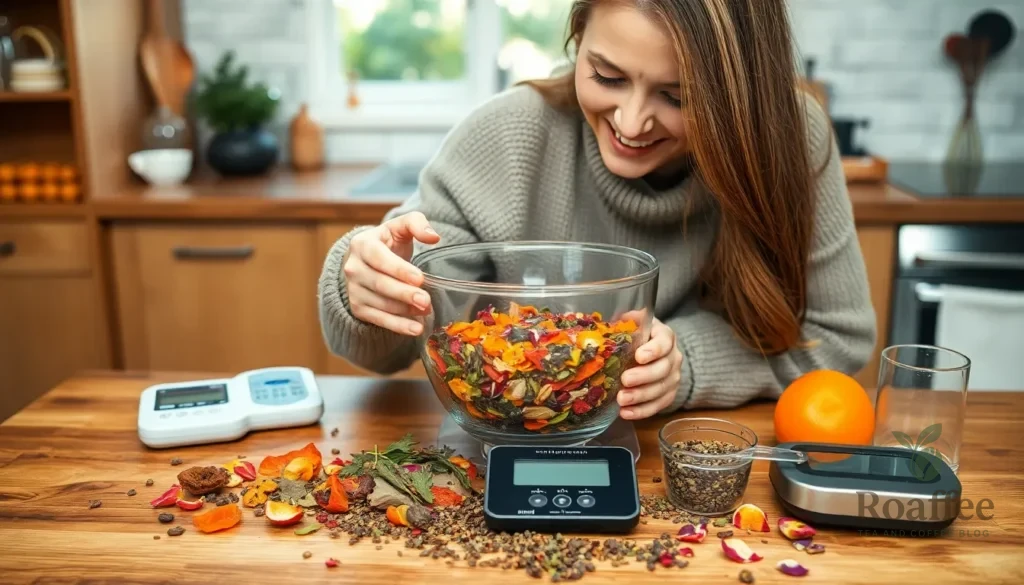There’s something magical about creating your own custom tea blends that transforms an ordinary cup into a personalized experience. We’ve all stood in the tea aisle wondering which flavors would work together or wished we could recreate that perfect blend from our favorite café. The good news? Making your own tea blends isn’t just possible – it’s surprisingly simple and incredibly rewarding.
When we create our own blends we’re not just mixing leaves and herbs – we’re creating signature flavors that reflect our unique tastes and preferences. Whether you’re drawn to energizing morning blends with citrus and spice or calming evening combinations with lavender and chamomile the possibilities are endless.
The best part about DIY tea blending is that we can control every ingredient ensuring quality while saving money compared to premium store-bought options. Plus there’s nothing quite like the satisfaction of sipping a perfectly balanced cup that exists nowhere else in the industry.
Essential Equipment for Tea Blending
Creating exceptional tea blends requires the right tools to ensure precision and quality in every batch. We recommend starting with these fundamental pieces of equipment that will serve you well throughout your tea blending journey.
Digital Kitchen Scale
Accurate measurements form the foundation of reproducible tea blends. A digital scale allows us to measure tea components by weight rather than volume, ensuring consistency across multiple batches. Look for a scale with precision to 0.1 grams and a capacity of at least 5 pounds to accommodate larger blending projects.
Mixing Bowls
Stainless steel or glass mixing bowls provide the ideal environment for combining tea ingredients. We prefer bowls with wide openings that allow us to see the blend’s color development and easily incorporate all components. Having multiple sizes on hand accommodates different batch quantities from small test blends to larger productions.
Airtight Storage Containers
Proper storage preserves the freshness and potency of our custom blends. Glass jars with tight-fitting lids or vacuum-sealed containers protect tea from moisture, light, and air exposure. We recommend containers sized appropriately for your typical batch sizes to minimize air space and maintain optimal freshness.
Fine Mesh Strainers
Multiple strainers with varying mesh sizes help us separate tea components and remove any unwanted particles. Fine mesh strainers work perfectly for sifting delicate herbs, while medium mesh handles larger tea leaves and botanicals. This equipment proves essential when working with crushed spices or powdered ingredients.
Measuring Spoons and Cups
Precise measuring tools ensure accurate proportions in our blends. We use a complete set of measuring spoons from 1/8 teaspoon to 1 tablespoon, plus measuring cups for larger quantities. Stainless steel options resist staining and maintain their accuracy over time.
Mortar and Pestle
Breaking down whole spices and releasing essential oils requires a quality mortar and pestle. This tool allows us to control the texture of our ingredients, from coarse crushes to fine powders. We recommend a marble or granite set for durability and effective grinding action.
Labels and Markers
Organization becomes crucial when experimenting with multiple blends. Waterproof labels and permanent markers help us track blend ratios, creation dates, and flavor notes. This documentation system prevents confusion and helps us recreate successful combinations.
Understanding Tea Base Types
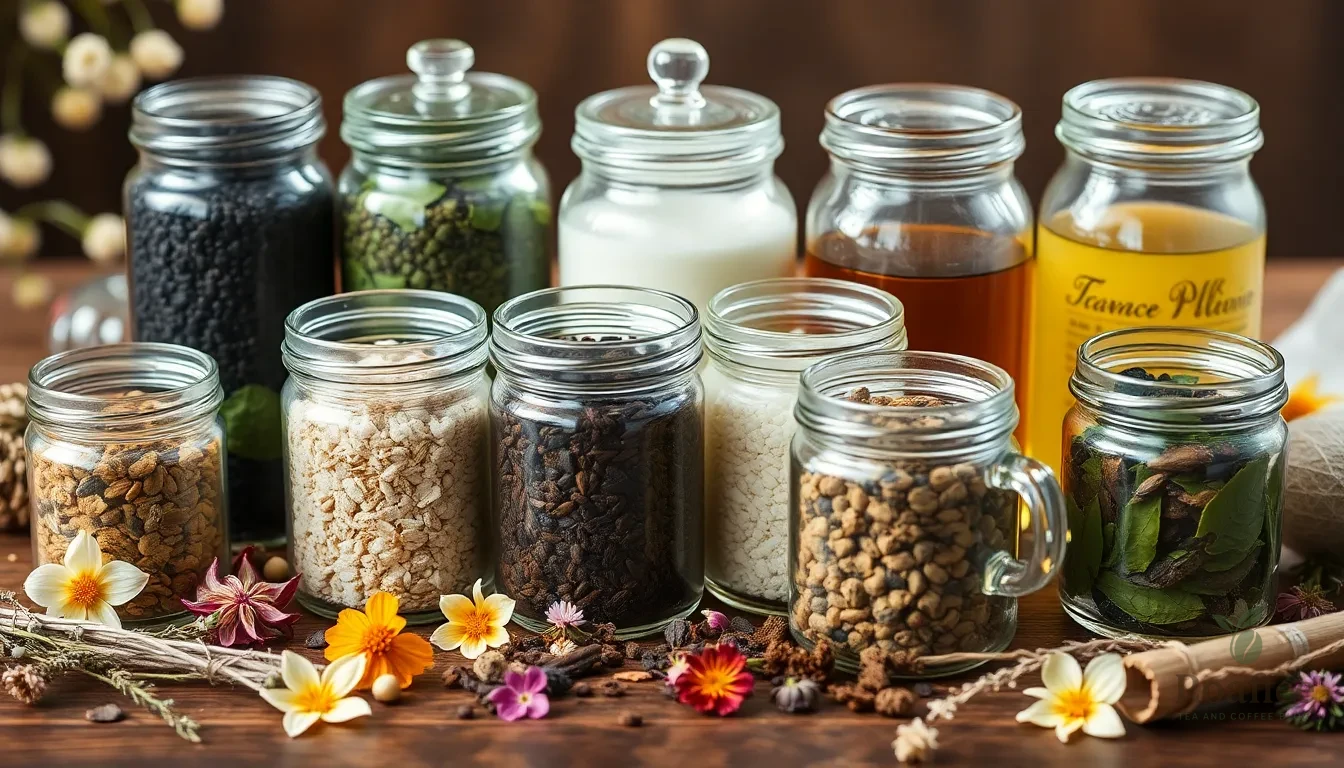
Building exceptional tea blends starts with selecting the right foundation. We need to understand each base type’s unique characteristics to create harmonious flavor profiles that satisfy our taste preferences.
Black Tea Bases
Black tea forms the backbone of many robust blends due to its full-bodied strength and bold flavor profile. We recommend using black tea as your primary base when crafting powerful morning blends or traditional afternoon teas. Popular varieties like Ceylon, Assam, or English Breakfast provide the sturdy foundation needed for complex blends such as Irish Breakfast or Earl Grey. The strong tannins in black tea can support heavier additions like bergamot oil, warming spices, or citrus peels without losing their distinctive character.
Green Tea Bases
Green tea offers a completely different foundation with its mild, earthy, and grassy flavor notes. We find green tea bases work exceptionally well for fresh or floral blends that highlight delicate ingredients. The subtle nature of green tea allows complementary flavors like jasmine, mint, or light citrus to shine through without overwhelming the palate. Sencha, gunpowder, or jasmine green tea varieties provide excellent starting points for afternoon or evening blends.
White Tea Bases
White tea presents the most delicate option among true tea bases, featuring mild and naturally sweet characteristics. We appreciate white tea’s gentle nature when creating sophisticated blends that showcase light floral ingredients like rose petals or chamomile. The subtle sweetness of white tea pairs beautifully with gentle herbs and requires minimal additional flavoring to create an elegant drinking experience. Silver needle or white peony varieties work particularly well for evening or meditation blends.
Oolong Tea Bases
Oolong tea strikes a perfect balance between green and black tea characteristics, offering floral and aromatic qualities with notable complexity. We value oolong bases for their versatility in both light and medium-bodied blends. The natural floral notes in oolong tea complement fruit additions, light spices, or additional floral elements without competing for dominance. Traditional oolong varieties provide an excellent foundation for afternoon blends that require more depth than green tea but less intensity than black tea.
Herbal Tea Bases
Herbal bases expand our blending possibilities beyond traditional tea leaves, offering caffeine-free alternatives with unique flavor profiles. We often use rooibos (red tea) for its naturally sweet and smooth character, which pairs well with vanilla, cinnamon, or fruit additions. Chamomile provides a soothing foundation for relaxing evening blends, while mint offers a refreshing base for digestive or cooling teas. These herbal foundations allow us to create specialized blends for exact purposes like relaxation, digestion, or bedtime routines.
Choosing Your Flavor Components
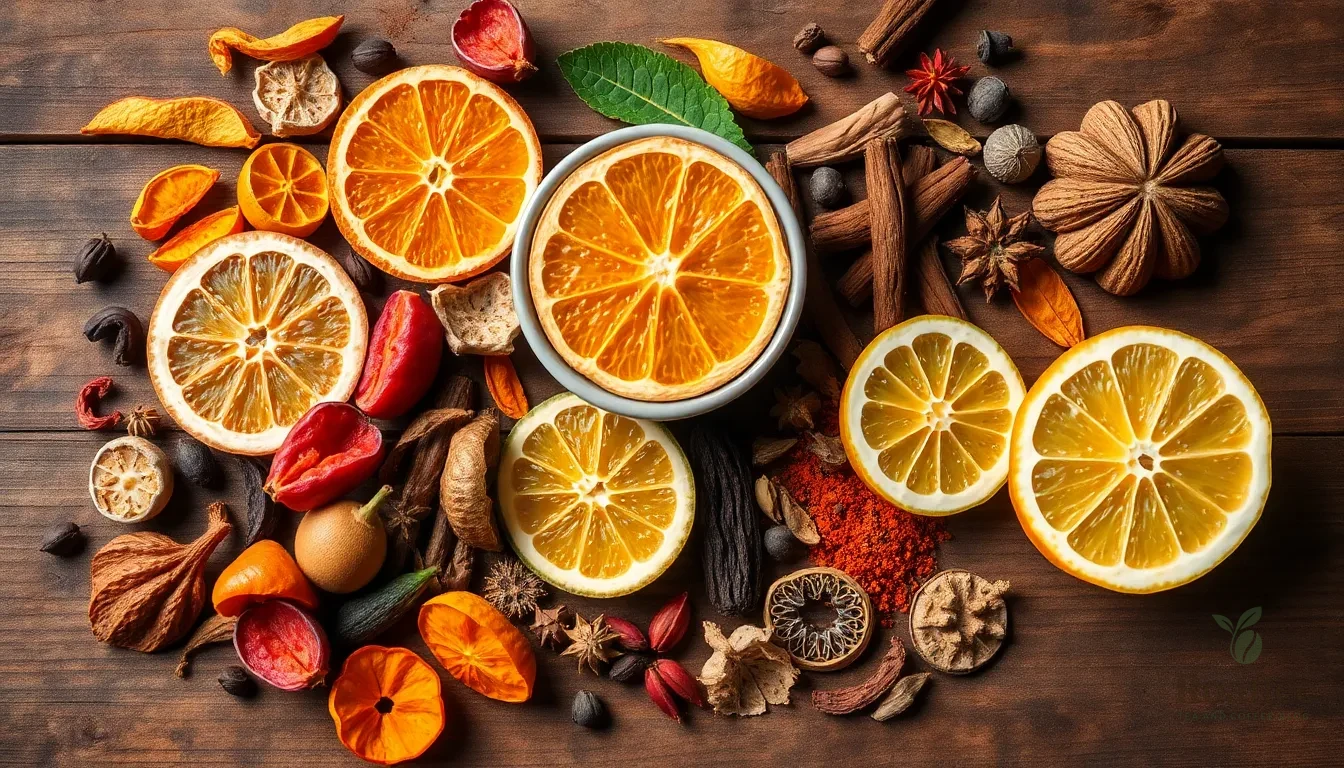
Building on our tea base selection, we now turn our attention to the flavor components that will transform your blend from ordinary to extraordinary. These carefully chosen additions work in harmony with your base tea to create depth, complexity, and unique taste profiles.
Dried Fruits and Citrus Peels
Dried fruits and citrus peels bring natural sweetness and vibrant flavor notes to our tea blends. Orange peel adds bright, tangy citrus notes that complement both black and green tea bases beautifully. Lemon peel provides a zesty kick that awakens the palate and pairs exceptionally well with herbal bases like chamomile. We recommend using organic citrus peels to avoid any unwanted chemical residues from conventional farming practices.
Apple pieces contribute gentle sweetness and a subtle fruity aroma that works wonderfully in autumn-inspired blends. Dried berries like cranberries or blueberries offer tartness and natural color that enhance both the visual appeal and taste of our creations. When selecting dried fruits, we always choose unsweetened varieties to maintain control over our blend’s sugar content and allow the natural fruit flavors to shine through.
Spices and Aromatics
Spices and aromatics serve as the “catalyst” ingredients that enhance both flavor complexity and potential health benefits. Cinnamon bark provides warming sweetness and supports digestive health, making it perfect for evening blends. Cardamom pods deliver a unique floral and slightly spicy note that elevates chai-inspired combinations.
Ginger root adds a warming kick that stimulates circulation and aids digestion, particularly beneficial in morning energizing blends. Black pepper might seem unusual, but it enhances the absorption of other beneficial compounds in our tea while adding a subtle heat. Licorice root contributes natural sweetness and helps balance stronger flavors, especially in herbal immunity blends.
We typically use these spices in small quantities, following the guideline of ¼ part spices to our base tea ratio. Fresh spices always deliver superior flavor compared to pre-ground alternatives, so we recommend purchasing whole spices and grinding them ourselves when possible.
Flowers and Petals
Flowers and petals introduce delicate floral aromas and visual beauty to our tea blends. Rose petals create romantic, perfumed notes that pair beautifully with black tea bases like Earl Grey. Lavender buds offer calming properties and a distinctive floral fragrance that works wonderfully in evening relaxation blends.
Hibiscus petals provide a tart, cranberry-like flavor along with stunning ruby red color that makes our blends visually striking. Chamomile flowers contribute gentle, apple-like sweetness and renowned calming effects, making them ideal for bedtime blends. Elderflower adds subtle floral notes with a hint of muscatel sweetness that complements lighter tea bases.
We always source food-grade flowers specifically intended for culinary use, avoiding decorative flowers that may contain harmful chemicals. These floral components soften and complement stronger tea bases while adding therapeutic benefits to our custom blends.
Essential Oils and Natural Extracts
Essential oils and natural extracts provide concentrated flavor intensity when used sparingly in our tea blends. Vanilla extract adds creamy sweetness that transforms simple black tea into a dessert-like experience. Citrus essential oils like orange or lemon deliver potent flavor bursts that can elevate an entire blend with just a single drop.
We must exercise extreme caution when using essential oils, as they are highly concentrated and can easily overpower our carefully balanced blends. One drop of essential oil typically flavors an entire ounce of tea blend, so we always start with less and gradually increase if needed. Food-grade essential oils are absolutely essential for safety and flavor quality.
Natural extracts offer a gentler alternative to essential oils while still providing concentrated flavor enhancement. Almond extract pairs beautifully with black tea bases, while peppermint extract adds refreshing coolness to green tea blends. We recommend testing these potent flavor enhancers in small batches before committing to larger quantities.
Basic Tea Blending Ratios
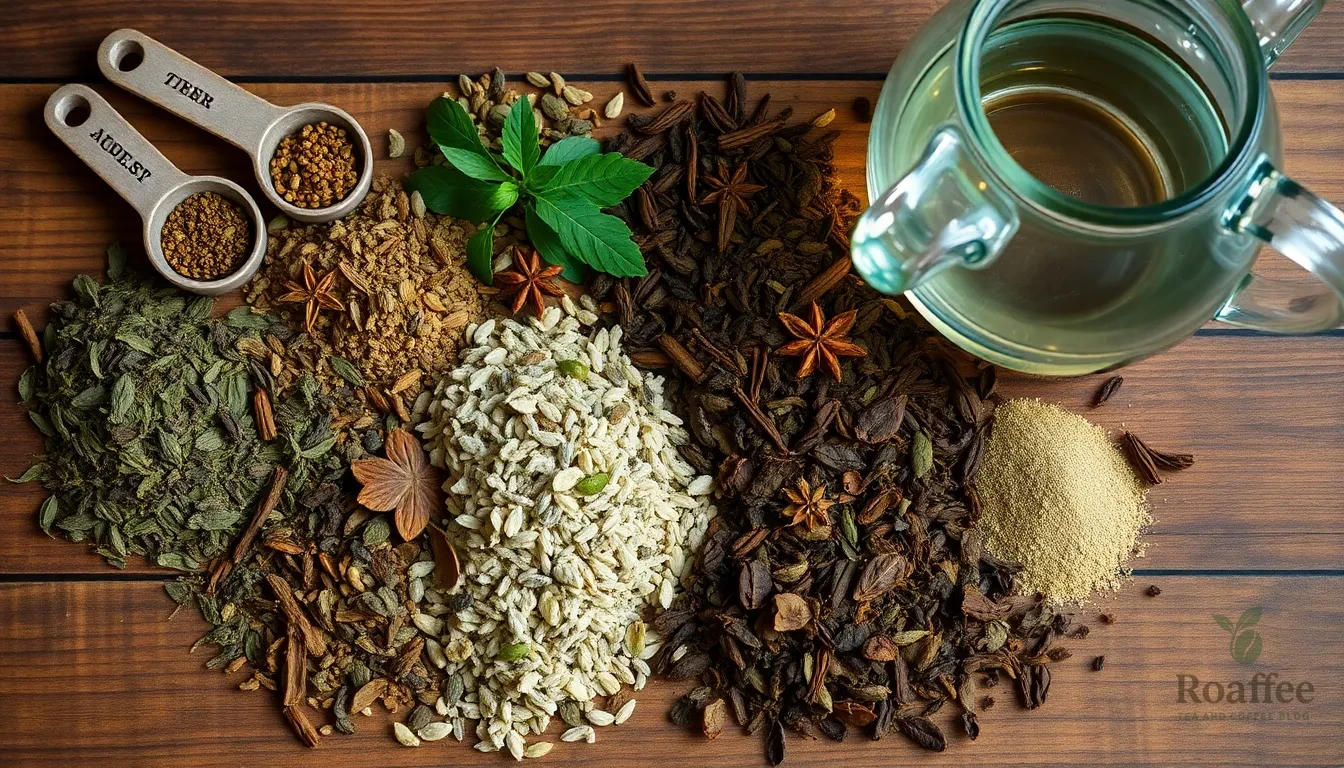
Understanding proper ratios forms the foundation of successful tea blending. We recommend following a structured approach that balances each component to create harmonious flavors without overwhelming any single element.
The fundamental structure relies on three distinct layers of ingredients. Our base ingredient serves as the foundation and should comprise 1 part of your total blend. This primary component establishes the overall character and body of your tea.
Supportive herbs function as middle notes and require ½ part of your total mixture. These ingredients add complementary flavors and often provide additional health benefits to enhance your blend’s complexity.
Catalyst herbs deliver the finishing touches as top notes and need only ¼ part of your blend. These potent aromatic herbs provide that final burst of flavor that makes your tea memorable.
| Component Type | Ratio | Purpose | Examples |
|---|---|---|---|
| Base Ingredient | 1 part | Foundation flavor | Green tea, black tea, rooibos, chamomile |
| Supportive Herbs | ½ part | Complementary flavors | Lemon balm, rose hips, blackberry leaf |
| Catalyst Herbs | ¼ part | Aromatic finishing notes | Cinnamon sticks, black pepper, lavender |
We find this ratio system particularly effective because it prevents any single ingredient from dominating the blend. The base provides stability while supportive herbs add depth and catalyst herbs create that distinctive character that sets your blend apart.
Starting with these proportions gives you a reliable framework for experimentation. You can adjust these ratios based on your taste preferences, but this foundation ensures balanced flavors that work together harmoniously rather than competing for attention.
Remember that some catalyst herbs like lavender or cinnamon possess intense flavors that can quickly overpower other ingredients. Using the ¼ part ratio for these components allows their essence to shine through without overwhelming the blend’s overall profile.
Instructions for Creating Your First Blend

Now that we understand the fundamentals of tea blending, let’s walk through the step-by-step process of creating your first custom blend. This structured approach ensures balanced flavors and helps you develop your blending skills systematically.
Step 1: Select Your Base Tea
We begin by choosing the foundation tea that will define our blend’s main flavor profile and caffeine content. Black tea serves as an excellent starting point for beginners since it provides a robust flavor that pairs well with most additives. Green tea offers a lighter, more delicate base that works beautifully with citrus and floral notes. White tea creates subtle, nuanced blends perfect for gentle afternoon sipping. For caffeine-free options, we recommend herbal bases like chamomile for calming evening blends or peppermint for refreshing digestive teas.
Starting with a simple base tea that you already enjoy drinking provides the best foundation for experimentation. This familiar flavor profile gives us a reference point as we add complementary ingredients to create our unique blend.
Step 2: Choose Complementary Flavors
We layer in middle notes to enhance complexity and depth in our tea blend. Botanicals such as nettle and dandelion leaf add earthy undertones that complement traditional tea bases. Dried fruit peels, particularly orange and lemon zest, introduce natural sweetness and bright citrus notes that lift the overall flavor profile.
Our top notes provide the finishing touches that activate the blend’s aromatic properties. Warming spices like ginger, cinnamon, and cardamom create memorable flavor accents that linger on the palate. These finishing elements should complement rather than overpower the base tea we selected in the previous step.
Step 3: Measure and Mix Components
We measure our ingredients carefully to ensure consistent results with each batch. Small experimental batches work best initially, allowing us to test combinations without wasting ingredients. A typical starting ratio uses 1 tablespoon of total dried herbs per 8 ounces of water when brewing.
Our mixing process involves measuring each component separately before combining them in a clean bowl. We gently stir the ingredients together, ensuring even distribution throughout the blend. The finished mixture gets transferred to an airtight jar for proper storage. We keep a detailed notebook to record exact ingredient ratios and combinations for future reference and adjustment.
Step 4: Test Small Batches
We brew small test portions of our blend to evaluate each component’s contribution to the overall flavor. Different tea types require exact steeping parameters, so we balance brewing temperature and time to accommodate all ingredients in our blend. Green tea bases need cooler water temperatures around 175°F, while black tea bases handle boiling water well.
Our testing approach involves tasting individual components first, then sampling the complete blend to understand how flavors interact. We note steeping times that bring out the best characteristics of each ingredient without creating bitterness or overwhelming any single element.
Step 5: Adjust Ratios as Needed
We refine our blend based on initial tasting results, tweaking proportions of base, middle, and top notes to achieve our desired flavor profile. This iterative process allows us to create both simple and complex blends that match our exact taste preferences.
Our adjustments focus on balancing dominant flavors while improving subtle notes that need more prominence. We increase base tea quantities if the blend tastes too herbal, or reduce strong spices if they overpower the foundation flavors. Each adjustment gets documented in our blending notebook for future reference and recipe development.
Popular Tea Blend Recipes to Try
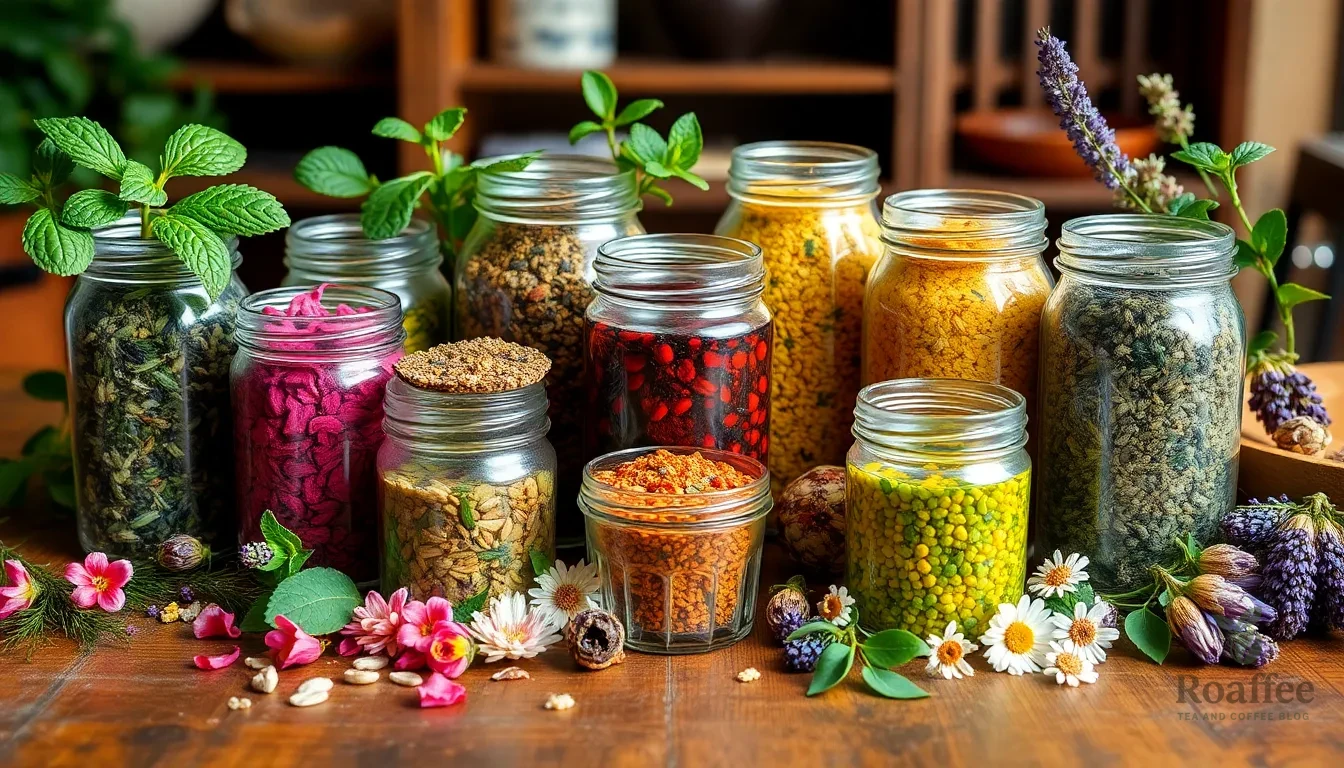
Now that we’ve covered the fundamentals of tea blending, let’s explore some tried-and-true recipes that showcase different flavor profiles and techniques. These blends offer excellent starting points for both beginners and experienced blenders looking to expand their repertoire.
Classic Earl Grey Blend
This vanilla-enhanced variation of the beloved Earl Grey creates a smooth and aromatic experience that appeals to traditional tea lovers. We recommend starting with high-quality Earl Grey tea as your foundation.
Ingredients:
- 1 cup Earl Grey tea
- 2 tablespoons cornflowers
- 1 chopped vanilla bean
Instructions:
- Combine all ingredients in a mixing bowl
- Blend thoroughly to distribute the vanilla and cornflowers evenly
- Store in an airtight container away from light
- Use 1 heaping teaspoon per 8 oz of hot water
- Steep for 3-5 minutes
- Strain and enjoy plain or with milk and honey
Warming Chai Spice Blend
Perfect for cold mornings or cozy evenings, this traditional chai blend delivers warming spices that energize and comfort. The combination of aromatic spices creates a complex flavor profile that pairs beautifully with milk.
Ingredients:
- 1 cup black tea
- 2 tablespoons cinnamon pieces
- 1 tablespoon cardamom pods
- 1 teaspoon whole cloves
- 1 tablespoon dried ginger pieces
- ½ teaspoon black peppercorns
Instructions:
- Lightly crush the cardamom pods and other whole spices using a mortar and pestle
- Mix all ingredients together in a large bowl
- Store in an airtight container for up to 6 months
- Steep 1 teaspoon of blend in hot water for 3-5 minutes
- Add milk or honey to taste
Refreshing Mint Citrus Blend
This invigorating blend combines cooling mint with bright citrus notes for a refreshing experience that works beautifully hot or iced. The light tea base allows the mint and citrus to shine through.
Ingredients:
- 1 cup green or white tea base
- 3 tablespoons dried mint leaves
- 2 tablespoons dried orange peel
- 1 tablespoon dried lemon peel
- 1 teaspoon dried lavender (optional)
- 1 teaspoon dried lemongrass (optional)
Instructions:
- Combine all ingredients in a mixing bowl
- Gently toss to distribute evenly
- Store in an airtight container for optimal freshness
- Use 1 teaspoon per 8 oz of hot water
- Steep for 3-5 minutes and strain
- Serve hot or pour over ice for a refreshing iced tea
Relaxing Chamomile Lavender Blend
This soothing herbal blend creates the perfect evening ritual for unwinding after a long day. The gentle floral notes promote relaxation while the lemon balm adds a subtle citrusy brightness.
Ingredients:
- 2 teaspoons chamomile flowers
- 1 teaspoon lemon balm
- ½ teaspoon lavender buds
- Gently mix all ingredients in a small bowl
- Store in an airtight container away from direct sunlight
- Use 1 teaspoon of blend per 8 oz of hot water
- Steep for 5 minutes to allow full flavor extraction
- Strain carefully and add honey if desired
| Blend Type | Steeping Time | Water Temperature | Serving Suggestion |
|---|---|---|---|
| Earl Grey Blend | 3-5 minutes | 200-212°F | Plain or with milk/honey |
| Chai Spice Blend | 3-5 minutes | 200-212°F | With milk or honey |
| Mint Citrus Blend | 3-5 minutes | 175-185°F | Hot or iced |
| Chamomile Lavender | 5 minutes | 200-212°F | With honey |
Proper Storage and Aging Techniques
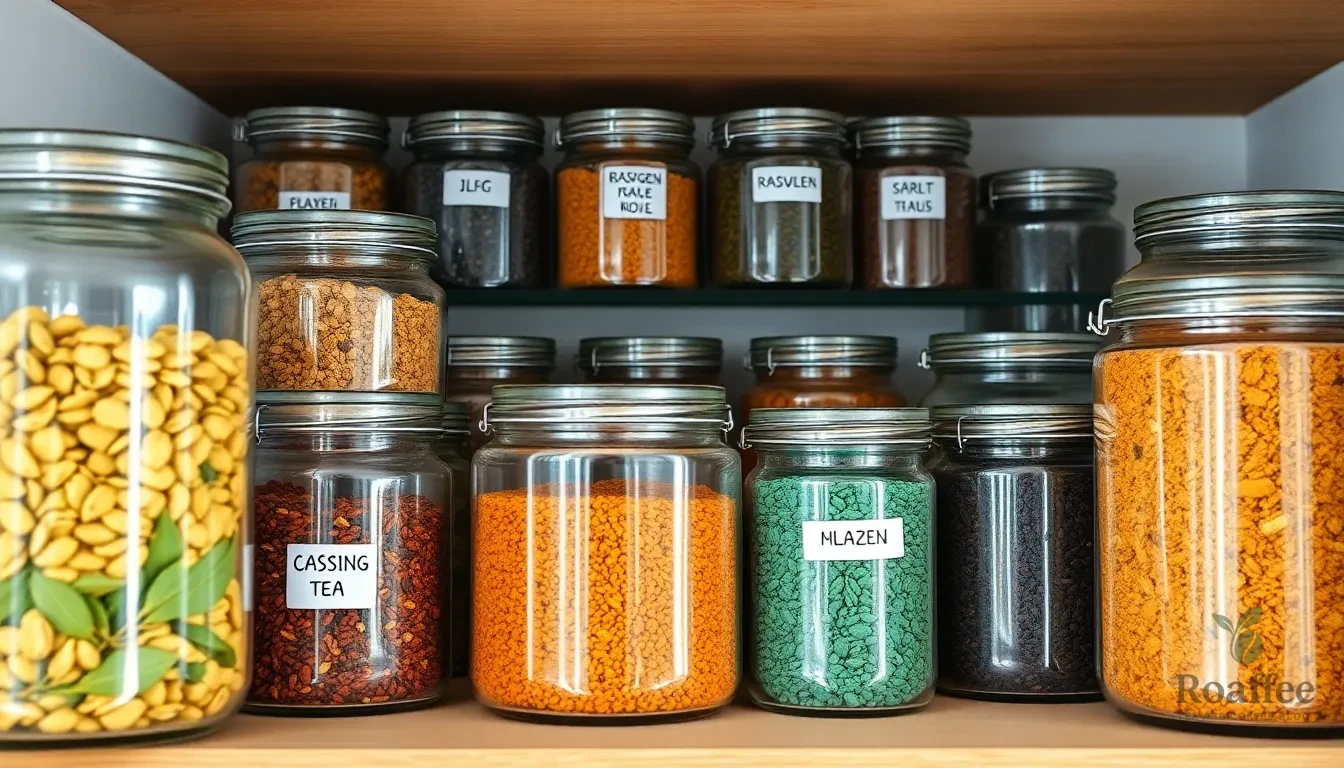
Once we’ve crafted our perfect tea blend, proper storage becomes essential to maintain freshness and develop deeper flavors over time. The way we store our custom blends directly impacts their longevity and taste quality.
Use Airtight Containers
We recommend investing in high-quality airtight containers made from glass or tin materials. These containers protect our blends from moisture, air exposure, and external odors that can degrade flavors and cause spoilage. Glass jars with tight-fitting lids work exceptionally well because they don’t absorb flavors from previous blends and allow us to see the contents clearly.
Prevent Moisture Damage
Moisture poses the greatest threat to our tea blends. We must ensure all herbs and fruits are thoroughly dried before blending to prevent mold growth. Fresh herbs should never be mixed directly into storage blends unless they’re completely dehydrated. If we want to add fresh elements, we should incorporate them only during the brewing process rather than storing them with the dry blend.
Choose the Right Storage Location
Our tea blends perform best when stored in cool, dark places away from heat sources and direct sunlight. Humidity can compromise the integrity of our ingredients, while heat and light accelerate flavor degradation. A pantry shelf or dedicated tea cabinet provides ideal conditions for both short-term storage and gentle aging processes.
Label and Date Your Blends
For proper inventory management and aging tracking, we should label each container with the blend name and creation date. Most custom tea blends maintain optimal flavor when consumed within 6 months, though some well-stored blends can develop more complex flavor profiles when aged properly under controlled conditions.
Systematic storage practices allow our carefully crafted blends to maintain their intended flavors while developing the nuanced characteristics that make homemade tea blending so rewarding.
Testing and Refining Your Blends
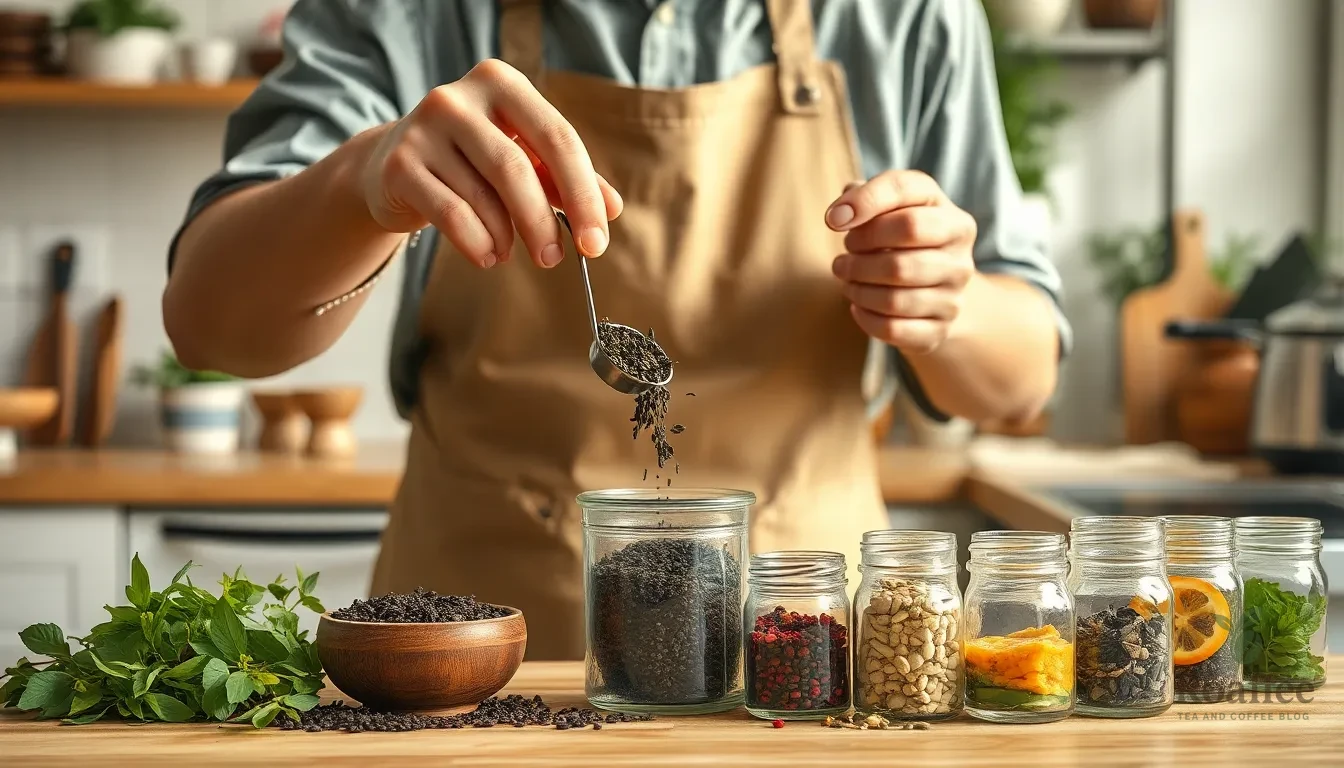
Creating the perfect tea blend requires patience and systematic testing to achieve the ideal flavor balance. We must carefully evaluate each iteration through controlled brewing methods and detailed tasting notes to refine our blends.
Brewing Methods for Testing
We recommend using specialized tools like tea balls, French press, or tea infuser bags to brew small sample quantities for testing. Measuring 2-2.5 grams or 1 teaspoon per 8 oz cup ensures consistent results across different test batches. A tea cupping set or white interior cups provides the best environment for observing infusion color and detecting subtle flavor nuances during our tasting sessions.
Steeping times should follow recommended guidelines for your tea base, typically 3-5 minutes for most teas. We maintain consistent water temperature and timing across all test brews to ensure accurate comparisons. This controlled approach allows us to isolate variables and understand how each ingredient contributes to the final blend.
Taking Tasting Notes
We taste each brewed sample carefully and record detailed observations about flavor profile, aroma, body, and aftertaste. Conducting side-by-side tastings of different blends or blend variations helps us detect subtle differences that might otherwise go unnoticed. Our tasting notes should include exact descriptors for each sensory aspect to guide future adjustments.
Recording these observations precisely creates a valuable reference for our blending journey. We document the exact ratios used, steeping parameters, and our impressions to track which modifications improve or detract from our desired flavor profile. This systematic approach prevents us from repeating unsuccessful combinations and helps identify promising directions for further refinement.
Making Adjustments
We create at least two variations of our blend with slight differences, such as changing one ingredient by 0.3 grams, to understand the impact of small modifications. Adjusting ratios of base herbs (green, black, or rooibos tea), supportive herbs (like lemon balm or rose hips), and catalyst herbs (such as cinnamon or black pepper) helps us balance flavor, aroma, and health benefits effectively.
Optional accents like dried flowers or citrus peel should be added sparingly to avoid overpowering the blend. We follow this iterative process:
| Step | Action | Purpose |
|---|---|---|
| 1 | Select and weigh ingredients individually | Establish baseline measurements |
| 2 | Combine ingredients in airtight container | Ensure even distribution |
| 3 | Brew small test batches | Maintain consistency |
| 4 | Taste and compare variations | Identify improvements |
| 5 | Adjust proportions or steeping times | Refine flavor balance |
| 6 | Repeat testing process | Achieve desired results |
Through this methodical testing and refining approach, we develop personalized tea blends with balanced flavor profiles and our desired effects. Each adjustment brings us closer to creating the perfect blend that reflects our individual taste preferences.
Make-Ahead Tips and Batch Preparation
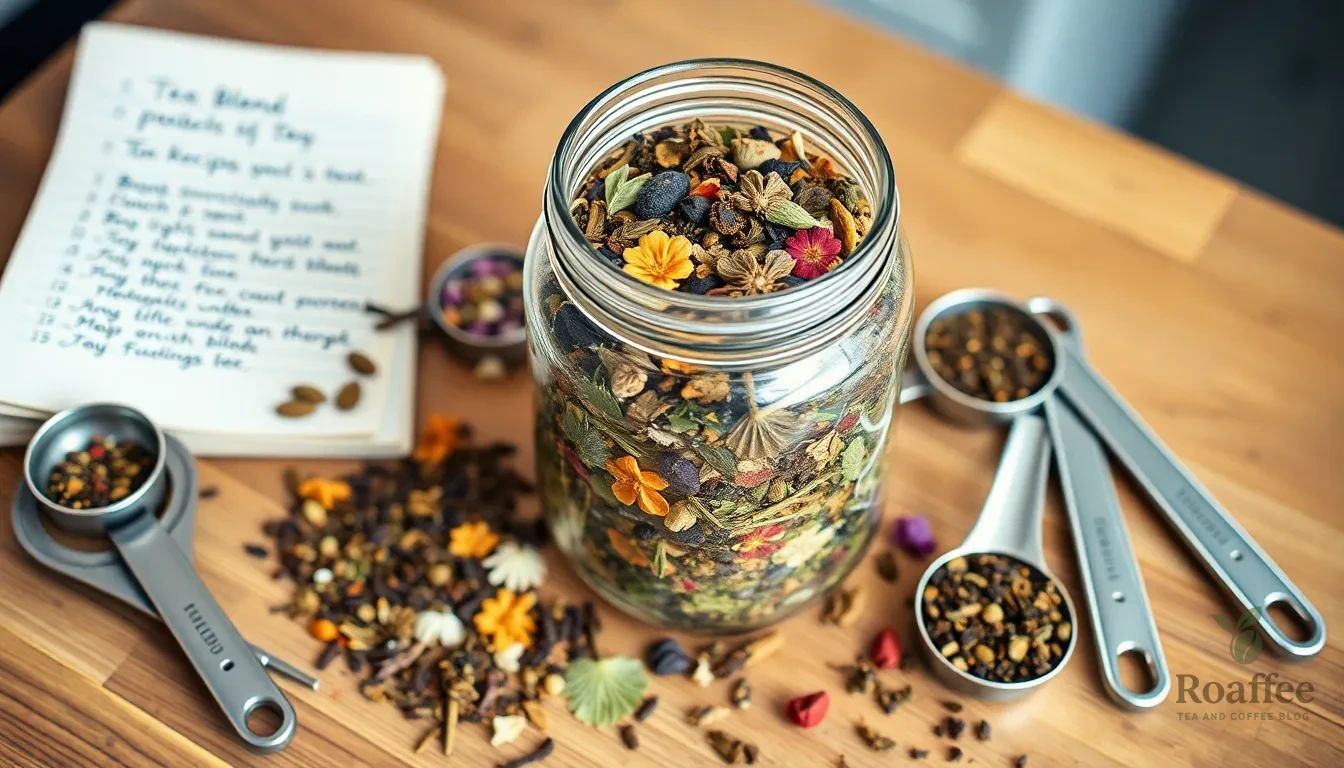
Preparing tea blends in advance transforms occasional tea crafting into a sustainable practice that saves time and ensures consistent quality. We recommend scaling your successful small batch recipes to create larger quantities while maintaining the precise proportions that deliver your desired flavor profile.
Creating Larger Batches
Starting with proven recipes allows us to multiply ingredient amounts confidently while preserving the balance that makes each blend special. When we scale up a recipe like our Vanilla Earl Grey blend, we maintain the same ratios by increasing 1 cup Earl Grey tea to 4 cups, 2 tablespoons cornflowers to 8 tablespoons, and the finely chopped vanilla bean proportionally.
| Batch Size | Base Tea | Supporting Herbs | Catalyst Herbs |
|---|---|---|---|
| Small (1 cup) | 1 cup | 2 tablespoons | 1 tablespoon |
| Medium (4 cups) | 4 cups | 8 tablespoons | 4 tablespoons |
| Large (8 cups) | 8 cups | 16 tablespoons | 8 tablespoons |
Storage Strategy for Batch Preparation
Proper storage becomes critical when preparing larger quantities of tea blends. We store our batches in airtight containers made from glass or tin, which protect the delicate oils and flavors from moisture and air exposure. Each container should be labeled with the blend name, creation date, and ingredient list for easy identification and inventory management.
Dividing large batches into smaller portions prevents frequent opening of the main container, which can introduce moisture and degrade quality. We recommend portioning blends into weekly or monthly amounts, keeping the bulk storage sealed until needed.
Timing Your Preparation
The best time to prepare batch blends is immediately after successfully testing and refining your recipes. Fresh ingredients provide the most vibrant flavors, and creating batches when your palate is familiar with the blend ensures consistency. We suggest preparing batches every 2 to 3 months to maintain optimal freshness while reducing preparation frequency.
Gift Preparation and Seasonal Planning
Batch preparation becomes especially valuable when creating tea blends for gifts or seasonal occasions. We recommend preparing holiday blends 4 to 6 weeks in advance, allowing flavors to meld while ensuring freshness at presentation time. This timeline provides adequate aging for complex blends containing multiple spices and aromatics.
Creating gift portions from larger batches maintains consistency across multiple recipients while reducing individual preparation time. We portion gift blends into smaller containers, typically 2 to 4 ounces, which provides enough tea for multiple tastings while ensuring recipients enjoy the blend at peak quality.
Gifting and Packaging Your Custom Blends
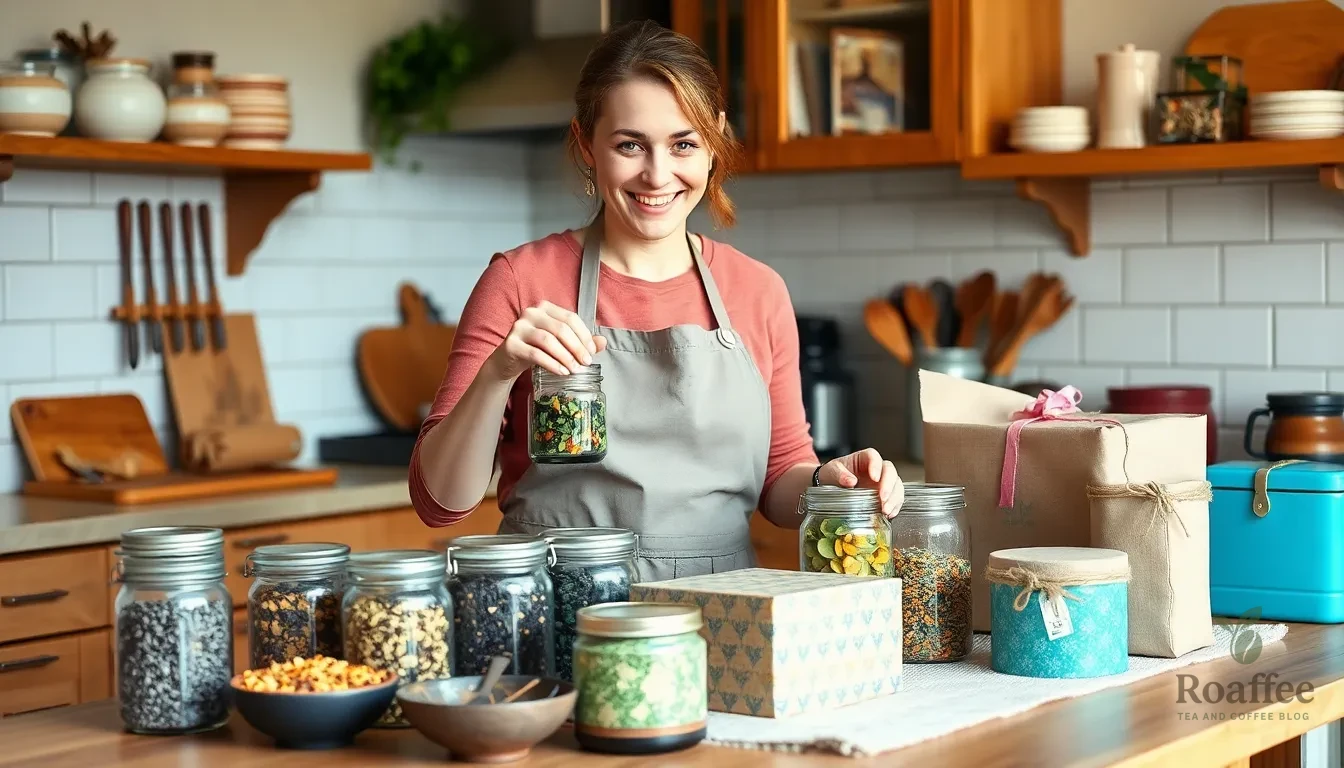
We understand that sharing our carefully crafted tea blends with loved ones creates meaningful connections and lasting memories. Creating beautiful packages transforms our homemade blends into thoughtful gifts that showcase both our creativity and care for the recipient.
Selecting the Right Containers
We recommend choosing airtight containers that preserve freshness while improving the gift’s visual appeal. Glass jars with secure lids work wonderfully for displaying colorful blends while protecting them from moisture and air exposure. Decorative metal tins provide another excellent option that combines functionality with aesthetic charm. Small kraft paper bags with fold-over tops offer a rustic approach that works particularly well for single-serving portions or sample sizes.
Creating Professional Labels
Our custom labels should include essential information while reflecting the blend’s personality. We need to include the blend name, complete ingredient list, and clear brewing instructions on each package. Adding steeping time recommendations and water temperature guidelines helps recipients achieve the perfect cup every time. Consider incorporating personal touches like the creation date or a brief description of the blend’s inspiration to make each gift more meaningful.
Brewing Instructions and Serving Suggestions
We should provide detailed brewing guidance to ensure recipients enjoy our blends at their finest. Include exact measurements such as 1 heaping teaspoon per 8 ounces of hot water with steeping times between 3-5 minutes depending on the blend type. Adding serving suggestions like “perfect for morning meditation” or “ideal as an evening wind-down ritual” helps recipients understand when and how to best enjoy their gift.
Packaging for Presentation
We can enhance our gift presentation through thoughtful packaging choices that protect the tea while creating excitement for the recipient. Wrapping containers in tissue paper or placing them in decorative boxes adds an element of surprise and care. Including a handwritten note explaining the blend’s unique qualities or sharing the story behind its creation makes the gift more personal and memorable.
Portion Planning for Gifts
Our gift portions should provide enough tea for multiple enjoyable experiences without overwhelming the recipient. We recommend packaging 2-4 ounces of loose leaf blend, which typically yields 15-30 cups depending on the blend’s density. Creating variety packs with smaller portions of different blends allows recipients to explore multiple flavors while discovering their preferences.
Preservation and Freshness
We must ensure our gifted blends maintain their quality from creation to consumption. Double-checking that all ingredients are completely dry before packaging prevents mold growth and maintains flavor integrity. Adding small silica gel packets to containers helps absorb any residual moisture, though we should clearly label these as non-consumable items for safety.
Conclusion
Creating your own tea blends opens up a industry of endless possibilities where creativity meets tradition. We’ve equipped you with the knowledge and techniques to transform simple ingredients into extraordinary beverages that perfectly match your taste preferences.
The journey from selecting quality bases to mastering proper ratios becomes more rewarding with each blend you create. Remember that every great tea blender started with their first experimental cup and learned through patience and practice.
Whether you’re crafting blends for daily enjoyment or preparing thoughtful gifts for loved ones your homemade creations will always carry that special touch that commercial teas simply can’t replicate. Start with our recommended recipes then let your imagination guide you toward discovering your signature blend.
Frequently Asked Questions
What equipment do I need to start making custom tea blends?
Essential equipment includes a digital kitchen scale for accurate measurements, stainless steel or glass mixing bowls, airtight storage containers, fine mesh strainers, measuring spoons and cups, a mortar and pestle for breaking down spices, and labels with markers for organization. These tools ensure precision and quality in your blending process.
What are the basic ratios for tea blending?
The fundamental ratio follows a three-layer structure: 1 part base ingredient, ½ part supportive herbs, and ¼ part catalyst herbs. This prevents any single ingredient from overpowering the blend while ensuring balanced flavors that work harmoniously together. Adjust ratios based on personal taste preferences while maintaining this foundational balance.
How long do custom tea blends last?
Most custom tea blends are best consumed within six months when stored properly in airtight containers in cool, dark places. Some blends can develop more complex flavors over time. Always ensure all ingredients are thoroughly dried before blending and label containers with dates for proper inventory management.
What are the best tea bases for custom blends?
Popular tea bases include black tea for robust flavors, green tea for fresh profiles, white tea for delicate blends, oolong tea for complex flavors, and herbal bases like chamomile or rooibos for caffeine-free options. Choose your base according to desired strength and flavor characteristics.
How do I test and refine my tea blends?
Start with small batches and maintain consistent steeping times and temperatures for accurate comparisons. Keep detailed tasting notes documenting flavor profiles and needed adjustments. Use a systematic approach to modify ingredient ratios based on taste tests, allowing patience for the iterative refinement process.
What flavor components work best in tea blends?
Excellent flavor components include dried fruits and citrus peels for natural sweetness, spices like cinnamon and ginger for warmth and health benefits, flowers and petals such as rose and lavender for delicate aromas, and essential oils or natural extracts for concentrated flavor. Use these sparingly to maintain balance.
How should I store my custom tea blends?
Store blends in airtight containers made from glass or tin to protect from moisture and air exposure. Keep containers in cool, dark places away from direct sunlight. Label each blend with ingredients and creation date. Ensure all ingredients are completely dry before storage to prevent mold and deterioration.
Can I make tea blends as gifts?
Yes! Custom tea blends make thoughtful gifts. Use attractive airtight containers like glass jars or decorative tins. Create professional labels with brewing instructions and ingredient lists. Package 2-4 ounces per gift for multiple servings. Include detailed brewing guidance and serving suggestions for the best recipient experience.

